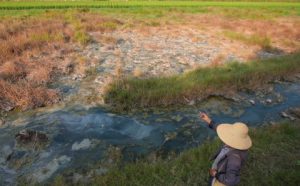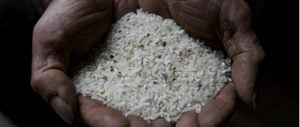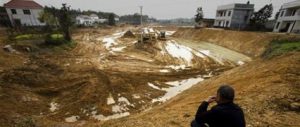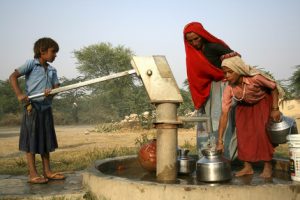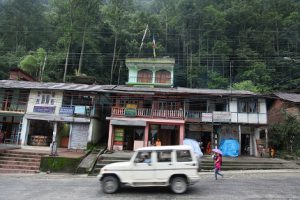Liu Hongqiao won the prize for "Best Investigation" for this article at the 2014 China Environmental Press Awards. The article was originally published in Caixin Weekly.
In February 2012, researchers carried out autopsies on two farmers who had died in summer 2009 in Liuyang in the southern province of Hunan. Pollution from a chemical factory had contaminated crops with cadmium, resulting in vegetables that were ‘grotesque and disfigured beyond recognition’.
The two farmers, Luo Lin and Ouyang Shuzhi, had extremely high urinary cadmium levels in their bodies. A total of 571 people from the same village showed elevated levels of the heavy metal, 208 of whom had already been diagnosed with cadmium poisoning. Around 260 hectares of village farmland were too polluted for crops.
Cadmium is one of the 10 most dangerous chemicals for public health, according to the World Health Organisation (WHO). Excessive intake damages kidney tubules and obstructs bone metabolism – causing kidney failure and bone lesions. Cadmium’s carcinogenicity has been widely confirmed.
Cadmium enters the body in two main ways: contact with the metal at the workplace and consumption of contaminated soil, water and food.
The autopsy report of the farmers is significant because officials have repeatedly denied that cadmium has ever been a cause of death. There is, however, convincing evidence that a huge number of people in China suffer from subclinical cadmium poisoning. Their cadmium levels meet or exceed the upper safety limit; even if no symptoms are present, they may develop in the future.
Even more worrying is the fact that China has yet to implement comprehensive and effective measures to deal with cadmium pollution. Currently, even when farmland is found to be heavily contaminated, cultivation of rice and other crops continues as though nothing is wrong.
The chemical company in Liuyang had a history of misconduct. It began production in Qiangqiao village, near Liuyang city in March 2003 at the invitation of the local government (despite its factory having been shut down in Changsha, the capital of Hunan province) due to pollution. In 2005 the plant was found to be illegally refining indium, a heavy metal, in March 2005 and again in the second half of 2006. The local environmental protection department banned their indium production facilities. But between April and November 2008, the plant was illegally refining cadmium, which led to the soil contamination in the area.
The raw materials for indium and cadmium refining are usually the tailings and slag from lead and zinc mines (cadmium is an impurity of lead and zinc ores). The accident investigation team determined that the company’s refining activities were directly responsible for Liuyang’s cadmium pollution incident.
Polluted legacy
Five years later cadmium pollution still looms heavy over Quangshiao village. Any new death of a resident who had been diagnosed with cadmium poisoning gives rise to panic. There have been 21 deaths from cancer or other diseases, said Luo Jinzhi, a local who keeps count of the deaths. All the deceased had been diagnosed with cadmium poisoning since 2009 and were living in three villages within a 1,200-metre radius of the plant – Qiangqiao, Jiankou, and Puhua. Thirteen of the deceased were younger than Liuyang’s average life expectancy of aged 73 and six were younger than 60.
Luo Jinzhi revealed that for those deceased villagers with abnormal cadmium levels, the government paid families between 10,000 and 59,000 yuan in compensation – for "funeral expenses".
One family member recalled that "funeral expenses" were calculated with regard to age and urinary cadmium concentration of the deceased. The younger the person, the higher the amount of "funeral expenses" paid.
The families were unable to file lawsuits, however, as the local hospital refused to provide evidence for the link between between cadmium poisoning and the deaths.
Wider contamination
Besides Luo and Ouyang, there were two more suspected cases of cadmium-related deaths in Hunan province.
Luo Shaokun died in February 2006, aged 66, in the village of Xinma – located in Tianyuan District near Zhuzhou City, just fifty kilometers away from Shangqiao. The reason for his death was never established. No autopsy was performed because the local government prevented it.
After his death, his family consulted a private medical institution that found Luo’s levels of cadmium in the urine and blood had been dangerously high. Urinary cadmium concentration was eight times higher than the national limit. This convinced the family that Luo Shaokun’s death was caused by cadmium poisoning.
The local government subsequently carried out a medical examination of 1800 Xinma villagers. 1100 people showed abnormal cadmium levels – 200 cases were severe. Liu Bingjie, then only 4 years old, topped the list with a concentration of 18.7 micrograms per gram.
On March 24 2008, after two years of treatment, the little girl died. Her death certificate issued by the hospital listed chronic cadmium poisoning as one cause.
A future epidemic?
The "cadmium rice" crisis in early 2013 put the issue of contaminated rice back into the spotlight. The health hazard posed by cadmium pollution, originating in major food producing areas such as Hunan and Jiangxi provinces, is currently spreading to other regions.
Researchers from the Chinese Academy of Sciences (CAS) collected samples from a hundred rice paddies – all located near mines – throughout Hunan province. They found that 65% of the samples exceeded the cadmium limit set by the national food hygiene authority. They also discovered that contaminated rice has repeatedly entered the local market as well as the national food supply network.
Given that rice is the main staple for southern China, the risks of cadmium contaminated rice should not be underestimated. Di Limei, researcher at CAS’s Institute of Geographic Sciences and Natural Resources Research, found that the residents of Shizhuyuan, a village near the city of Chenzhou (Hunan Province), consumed an average of 596 micrograms of cadmium through rice and vegetables per day. According to a WHO publication the “Itai-Itai disease”, this is approximately what the Japanese victims had also consumed. Another report put the number even higher, finding that some people who live in heavily contaminated areas consumed an average of 1,850 micrograms per day.
Unfortunately, residents living in areas known to be contaminated are seldom able to change local farming conditions and their diet, and thus continue consuming contaminated rice, vegetables, and water.
Shang Qi of the Center for Disease Control (CDC) has studied cadmium’s health impacts for nearly 20 years. To assess comprehensively the health damage in polluted areas, CDC will complete a survey of 5,000 people from around the nation, encompassing all known cadmium-polluted areas in China.
Initial results indicate that the proportion of samples with urinary cadmium concentrations exceeding the national limit of 5 microgram per gram is "very big," he says. The proportion of samples exceeding the more lenient WHO standard of 10 micrograms per gram "is still considerable."
Apart from damaging kidneys and bones, cadmium also has an impact on disease and mortality rates, i.e. non-specific damage. However, as China’s monitoring system of non-infectious diseases and mortality is lagging far behind, there is currently no credible data tracking cadmium pollution’s impact on disease and morbidity rates.
Nobody knows exactly how the "hidden" effects of cadmium will hurt the people currently suffering from excessive urinary cadmium. And it is unknown whether they will be subject to cadmium’s non-specific damage in the future.
Shang Qi doesn’t think the situation is entirely bleak. "Multiple bone fractures are the typical symptom of ‘Itai-Itai disease’, but not a single case has been found in China. Serious bone damage, heralded by bone softening, has as of yet also not been observed."
Shang Qi explains that "once cadmium enters the soil it is difficult to remove and once it enters the body, it cannot be quickly discharged. The most important thing to do is cutting off the channels through which cadmium enters the body; it is key to implement effective measures in polluted areas that can block cadmium."
Ideally, these measures would be immediately implemented. This would spare the younger generation from facing serious health problems and would make sure that cadmium’s disastrous impact would gradually become history.
On January 28, 2013, the State Council issued a directive called "Plans for Future Protection and Comprehensive Management of Soil". The directive calls on local governments to ban crop production on arable land with high levels of cadmium. This move signifies a big step forward by the national government in circumcising cadmium’s health damage on food sources. But as always, translating the document into action will be a long and difficult road.
